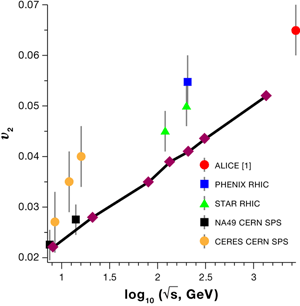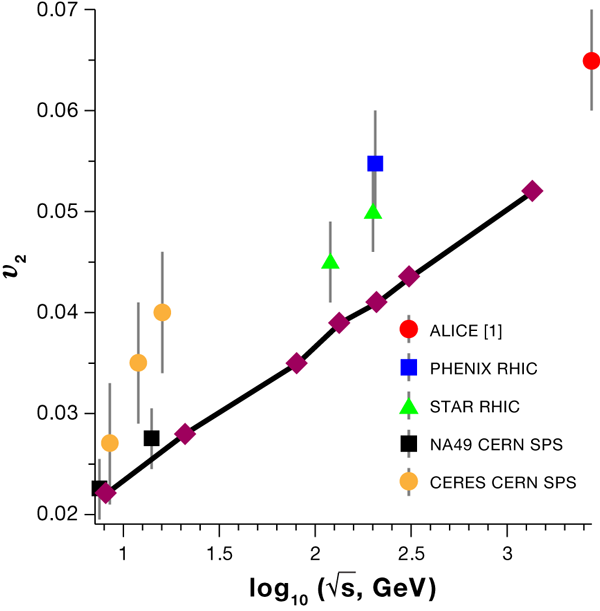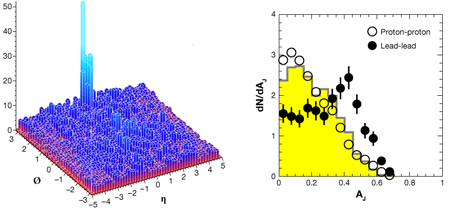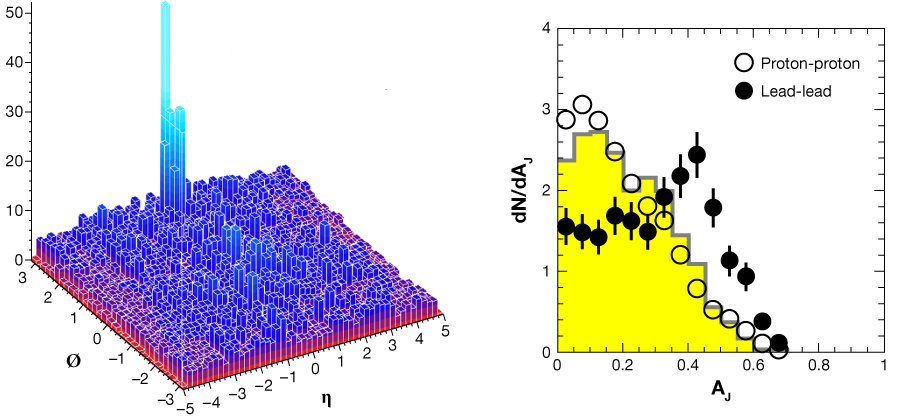A “Little Bang” arrives at the LHC
In November, the Large Hadron Collider (LHC) at CERN began its first heavy-ion run, producing lead-lead collisions with the highest center of mass energy ever achieved. Now, a pair of papers appearing in Physical Review Letters, from the ALICE [1] and ATLAS [2] experiments at the LHC, presents a first glimpse of what new information these high-energy collisions will offer about the quark-gluon plasma—the state of matter believed to have filled the universe at the time of the Big Bang. The ALICE results strongly indicate that the quark-gluon plasma remains a nearly ideal liquid, as seen earlier at the Relativistic Heavy Ion Collider (RHIC), even at significantly higher energies. Complementing this work, the ATLAS team has shown that even very high energy jets of particles emitted from the collision lose a large fraction of their energy into the quark-gluon plasma (and are sometimes completely dissipated), a sign that the quarks and gluons are strongly interacting with the hotter plasma.
The quark-gluon plasma (QGP) is the extreme state of matter that occurs above a critical temperature ( trillion degrees Kelvin). Unlike the world we live in, where quarks and gluons are not free, but bound into nucleons, the QGP can be viewed as a plasma consisting of quarks and gluons that interact via Coulombic forces. (The “color” charge of quarks and gluons determines the strength of the strong force in the same way that electric charge determines the strength of the electromagnetic force.) Laboratory collider experiments seek to understand the strength of these forces and their effect on the properties of the QGP.
Prior to experiments in 2000 at Brookhaven National Laboratory’s RHIC facility, the main question was how best to study the thermodynamics and kinetics of the quark-gluon plasma. In particular, knowing the mean free path of particles in the plasma was important because it determined whether the QGP behaved as a liquid or a gas. The RHIC experiments essentially answered these questions by observing the explosion (the “Little Bang”) created in the collision of high-energy gold ions. The experiments showed that the resulting plasma could be excellently described by a hydrodynamic picture of a nearly ideal liquid, in which particles had a mean free path that was effectively zero.
The detectors at RHIC and the LHC capture the dynamics of the explosion by measuring the symmetry of the subsequent flow of particles: the radial flow ( ), the elliptic flow ( ), the triangular flow ( ), and so on. (These are actually the Fourier components of the flow, projected onto the harmonics , where is the angle that wraps around the line of collision). The components depend on the impact parameter (that is, how “head on” the colliding nuclei are), the particle types, and their transverse momenta.
At RHIC, measuring how these flow components vary with different experimental conditions provided information about matter in a temperature range between and . The LHC has a higher collision energy than RHIC and is therefore expected to produce hotter matter. Showing that this is indeed the case, a companion paper from ALICE provides the first measurement of the density of charged particles produced in the collisions [3]. ALICE determined the number of charged particles, or “multiplicity” of a collision, as a function of the “pseudorapidity”—a measure of the angle of particle trajectories with respect to the line of collision. By measuring the multiplicity, ALICE was able to calibrate the temperature of the plasma at the LHC compared to that produced at RHIC, yielding (at early times in the explosion) the relation between the temperatures . However, the initial temperature at the LHC could be even higher, since it is likely the plasma equilibrates at an earlier time than at RHIC.
Some researchers expected that the QGP produced at the LHC would switch to a regime where quarks and gluons were more weakly coupled at higher temperature. If so, the mean free path of particles in the plasma and the viscosity should be larger, the experimental signature of which would be smaller flow components . However, as the ALICE results [1] have clearly shown, this is not the case. As seen in Fig. 1, the parameter that characterizes the elliptical nature of the liquid flow, , has actually grown by about , exactly as predicted by the (ideal) hydrodynamics a decade ago [4]. The dependence of on transverse momentum is nearly identical to what was measured at RHIC, and ALICE has shown that the radial flow also grows with energy (a result that will be described elsewhere).
One of the other important discoveries at RHIC was that particle jets are strongly quenched when they interact with the quark-gluon plasma. Pairs of energetic particle jets are produced when quarks and gluons in the colliding nuclei happen to scatter from each other at large angles. If the jets are produced near the edge of the plasma, the jet that moves outward will be detected, unchanged in energy, but the one that has to move through the plasma loses a lot of energy. At RHIC, the transverse energy of jets observed was about – , which made it difficult for detectors to see them against the large and fluctuating background of thousands of particles. The higher energy available at the LHC, as well as ATLAS’ excellent finely granulated calorimeter, makes it possible to detect and measure jets with a transverse energy from to well above (Fig. 2, left). In central lead-lead collisions, the probability of a large jet asymmetry (that is, one jet arriving into the detector with more energy than its partner jet that moves in the opposite direction) turns out to be completely different from that in proton-proton collisions. Since there is no quark-gluon plasma to stop them in the latter case, both jets tend to have about equal energy, but in lead-lead collisions, in which the second jet is forced to move through the plasma, the measured asymmetry implies that, on average, more than half of the jet energy is lost (Fig. 2, right). ATLAS has also observed extremely asymmetric events, in which such high-energy jets basically dissipated entirely, without a companion jet.
What do these results tell us about the quark-gluon plasma? The mean free path for particles in the plasma can be conveniently expressed via a dimensionless ratio , where is the shear viscosity, is the entropy density and is Planck’s constant. In a weakly coupled quark-gluon plasma, the mean free path should be large , while it should be small in a strongly coupled plasma. RHIC data analysis has shown it to be extremely small, close to the theoretically conjectured lower limit for infinitely strong coupling [5]. That this strong-coupling picture holds for the QGP seen at the LHC seems now likely. Naively, one might have expected that compared to the jets produced at RHIC, the higher energy jets available at the LHC would travel further through the plasma before completely dissipating their energy, but the ATLAS measurements showed that the stopping distance for a jet is comparable to the radius of lead nuclei used in the collisions. (The deposited energy/momentum goes into a shock or sound wave [7,8], which still has to propagate for some time, until the final freeze-out, when it turns into the observed hadrons.) One theory that could explain this surprising result is a strong coupling theory called the AdS/CFT correspondence, a spin-off from string theory that relates the strong-coupling limit of quarks and gluons to a theory of gravity in a higher dimension. In the AdS/CFT picture, the equilibration of the quark-gluon plasma is connected to the production of a black hole, and jet quenching can be mapped to falling into this black hole (for reviews, see, e.g., Refs. [9,10]). Predictions based on this theory suggest that the stopping distance of a jet varies as [6], which means that at the LHC, a jet with stops at the same distance as a jet at RHIC—similar to what ATLAS observed. Collectively, these results from ALICE and ATLAS are providing new evidence that the quark-gluon plasma produced at the LHC is still strongly coupled. After just three weeks of the LHC run with heavy ions, we are witnessing a very exciting start of this new era.
References
- K. Aamodt et al. (ALICE Collaboration), Phys. Rev. Lett. 105, 252302 (2010)
- G. Aad et al. (ATLAS Collaboration), Phys. Rev. Lett. 105, 252303 (2010)
- K. Aamodt et al. (ALICE Collaboration), Phys. Rev. Lett. 105, 252301 (2001)
- D. Teaney, J. Lauret, and E. V. Shuryak, Phys. Rev. Lett. 86, 4783 (2001)
- G. Policastro, D. T. Son, and A. O. Starinets, J. High Energy Phys. 0209, 043 (2002)
- P. M. Chesler, K. Jensen, A. Karch, and L. G. Yaffe, Phys. Rev. D 79, 125015 (2009)
- H. Stöcker, Nucl. Phys. A 750, 121 (2005)
- J. Casalderrey-Solana, E. V. Shuryak, and D. Teaney, J. Phys. Conf. Ser. 27, 22 (2005); Nucl. Phys. A 774, 577 (2006)
- I. R. Klebanov and J. M. Maldacena, Phys. Today 62, No. 1, 28 (2009)
- E. Shuryak, Prog. Part. Nucl. Phys. 62, 48 (2009)







